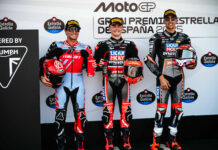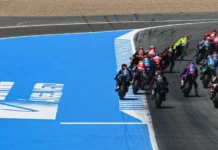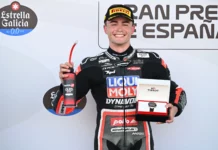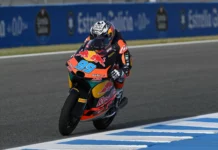FIRST PERSON/OPINION:
By Michael Gougis
Arguments over the greatest rider of all time are essentially entertaining-yet-pointless exercises. Barring the invention of a time machine, it is impossible to objectively judge how a rider on any given machine on a particular tire in one year compares against the skills of another rider on a different machine (or that same machine) on different tires in a different year. It’s impossible to say at the end of a given race which rider was better on a given day, regardless of who won. It’s entirely possible to argue that the rider who came from a horrible qualifying spot on the grid to fourth was the best rider of the day.
It is entirely possible, however, to make an absolutely objective, unassailable argument about the relative advantages and disadvantages a given rider had during their careers. During certain periods, some riders are given such immense advantages that, win records aside, it’s hard to argue that it is only their skill that earned them their domination. It is the nature of the sport that introduces this variable–a talented rider will be given, by a factory team and supporting companies determined to win above all else, every single advantage they can muster. Yes, it helps guarantee the success that the companies crave. But it also reduces the ability to truly judge the rider’s skill in comparison to other racers.
The central idea of this column is simple: No other multi-time World Champion has raced with fewer of the equipment advantages of the epoch-definers of modern motorcycle road racing than Marc Marquez. I’ve long marveled at his sheer talent and speed–what he did in the supporting classes bordered on criminal–but I’ve been pondering during my morning runs why I’m so impressed with what he’s done in MotoGP.
And this is why: In every other period, the defining Champion had an Unfair Advantage (phrase gleefully stolen from the autobiography of car racer, engineer and racing genius Mark Donohue, a must-read for any race fan). Marquez has raced during a period when MotoGP’s rulemakers have–in a very literal sense–stripped him of the advantages that his predecessors enjoyed.
Consider:
Giacomo Agostini is legendary, with 122 Grand Prix race wins to his name. And his talent is legendary, as he proved in titanic battles with full factory efforts by Honda-mounted Mike Hailwood in 1967. But Honda left the sport the following year, and Ago literally raced the factory-backed multi-cylinder MV Agusta against a field of privateers on single-cylinder machines. His win total is impressive, but … after battling to the 500cc titles in 1966 and 1967, Ago–on essentially, the sole factory machine in the field – won every 500cc and 350cc race in 1968, all but one of the 350cc races in 1969, every race in those categories in 1970 … you get the idea. Such was the mechanical dominance of the MV Agusta that, as Colin MacKellar writes in his history of Yamaha GP machines, the 1973 season finally showed enough competition from the emerging Yamaha two-strokes that “there was the forgotten sight of MV engine blocks being opened in the grass fields accurately called ‘paddocks’ at the GP circuits. For the previous five years, the MV’s had been taken out of the truck, dusted off, filled with oil and fuel, raced, garlanded and loaded back onto the truck.” The advanced MV Agusta, and a lack of factory competition, was Ago’s Unfair Advantage.
Mick Doohan’s era–five straight 500cc World Championships–started as Honda introduced the “big-bang” firing order for its four-cylinder NSR500. It was such a clear advantage that the other factories copied it, but Honda had gotten the technology and the application right, first. As the other factories caught up, Doohan was racking up wins and titles. Then, just as every other rider on the grid was coming to terms with the “big-bang” motors, Doohan tried the old, even-firing-interval engine again and found it faster, easier to handle, easier on tires and a motor configuration no other rider wanted to try! “The bike to me feels better. The other guys are not used to this style engine. They have grown up with the ‘big bang’ … This is better for me, and I think the others have been scared off by the rumors of how the old ones used to be,” Doohan says in MacKellar’s awesome book on Honda’s GP racers.
Valentino Rossi inherited Doohan’s winning team at Honda, including legendary Crew Chief Jeremy Burgess. When the Rossi era started, he took the dominant Honda to title after title, then took Burgess with him to Yamaha, where the two of them revamped the Yamaha into a title-winner. Rossi had Burgess, and one other Unfair Advantage–tires. Michelin were the hot property during this period, and Rossi had access to the company’s “overnight specials.” These were, literally, tires that Rossi could test on the Friday of a race weekend, give feedback to the company, who would cook a new tire, specially honed for the track and conditions, and fly it to the track for race day. Rossi was not the only rider who had these “overnight specials,” but the majority of the field didn’t. And as Rossi was one of the winningest riders in the series at the time, Michelin likely would have paid more attention to what he wanted in a race tire. The extent of this Unfair Advantage was made clear when the “overnight specials” were banned, and Rossi’s results nose-dived so dramatically that after Casey Stoner took the 2007 title, Rossi switched to Bridgestones, and a year later MotoGP adopted the spec tire rule.
What’s noteworthy here is that the move to spec tires was the first step in “leveling the playing field” moves that have led to the current MotoGP machines.
Fast-forward a bit to the Marquez era. Winner in his first crack at a MotoGP title, he humiliated the field in his second season. Arguments raged that Honda’s superior machine was ruining the racing. Never has Marquez had access to special tires; his entire MotoGP career has taken place on spec tires, at first Bridgestone, then Michelin. No advantage there. Testing restrictions never have been tighter. During his career, first the electronics hardware was standardized, then the software was standardized for the entire field. Engine limits were introduced, with engine specifications “frozen” for long periods during the season. Fuel consumption was restricted. Teams and factories that performed poorly got extra engines and extra testing, to help them catch up. And MotoGP execs spoke openly about making sure they had a “show” to sell–which is another way of saying that they weren’t going to allow another Doohan-esque period to manifest itself if they could do anything about it.
It is in this era that Marquez’ accomplishments have to be seen. Marquez has 39 wins and 69 podiums in MotoGP during an era where the rules are stacked against anyone winning that much. It’s unlike any era before in racing, an era designed to prevent the emergence of a superstar, yet Marquez has done just that anyway.
I’ll wrap this up with a hypothetical question: If the rules were the same as they were in 2014 for the machine (no spec electronics), Marquez had a legendary crew chief in his garage, and Michelin would cook special tires for him for specific tracks for specific race weekends … would he ever lose a race again?






